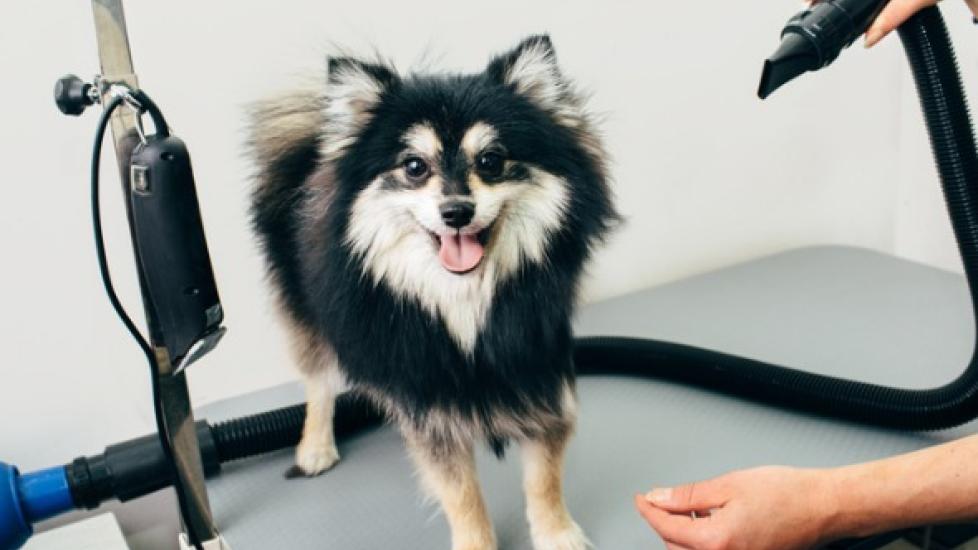Tips for Getting Your Dog Comfortable with a Dog Dryer
Image via iStock.com/Darunechka
By Carol McCarthy
Bath time is no fun for most pets, and if your pet hasn’t been properly introduced, a dog dryer can add insult to injury, with its startling noise and unwelcome blasts of air. But professional pet groomers and pet parents who groom and bathe their dogs at home often use dog hair dryers to speed up the grooming process.
With patience, expert advice and the right tools, your dog can become comfortable with a dog dryer—making bathing and grooming easier for both person and pet.
How to Introduce a Dog Dryer
To ease your dog’s discomfort, you must gradually desensitize him to the dog dryer, says Christina Potter, a columnist, author and dog training professional.
“The desensitizing phase can take as little as one to two sessions of about a minute each, to a few days, depending on how afraid your dog is,” she explains. “You definitely don’t want to move through it too quickly, and stay really positive.”
Therese Backowski, a longtime trainer, groomer and international grooming judge, says her number one dog grooming tip is to go slowly when introducing your dog to a dog hair dryer. “Because dogs hear so much better than we do—what is loud to us is almost intolerable to them. I go very, very slowly,” says Backowski, who has trained dogs for such films as “Shawshank Redemption.”
You can also consider placing cotton balls in the ears or using ear protection equipment that’s made specifically for dogs. Be sure not to push the cotton balls into the ear canal, and remember to remove them after grooming.
How to Groom a Dog Using a Dog Hair Dryer
Potter says, “Start with the dryer on a low setting with no heat, pointed down. Have your dog in a small room, such as a bathroom, and allow him to move away from the dryer. Don’t make a big deal when he does. Have high-value treats with you and feed them to your dog, one at a time, while the dryer is running.” As your dog gets more comfortable, she says, “Move your hand with the treats in them closer to the dryer each time, making sure you don’t blow the air into your dog’s eyes or ears.”
Backowski also makes sure to cover a dog’s ears and eyes, as well as their paws, when she introduces the dryer. She begins with the dog dryer setting on cool, not cold. “The last thing I want to do is blast a frightened dog with cold air,” she says.
In her grooming salon, Backowski uses verbal praise and petting to reward dogs who are too stressed to take dog treats, adding that in a professional setting, the dog groomer might not know what treats a dog can safely have.
Both experts agree that if your dog shows signs of unease, it is important to stay calm and not to scold or praise them, but to have a neutral response. “If your dog is afraid, don’t try to comfort him by saying ‘it’s okay’ or anything like that, because then you’re telling your dog that his reaction of fear is ‘okay,’ when it’s not. Praise your dog as he takes treats,” Potter explains.
Once your dog is fine with the low setting on the dog dryer, repeat the same steps with higher settings. Never add so much heat that it could harm your dog. Use your hand to move the fur around while blow drying so you can make certain not to burn the skin. If it feels too hot on your hand, then it will definitely be too hot for your dog.
Dog Grooming Tips to Keep Your Dog Calm and Comfortable
Keep initial sensitivity training sessions short, Potter stresses. “If your dog is small, put him in your lap and give him treats as you move the dryer closer.”
For large breeds, she suggests investing in a dog grooming table for the dog dryer, so you can use both hands—one for treats, and one to hold him in place and guide him.
Backowski says that dog grooming and bathing should always be preceded by a complete and thorough combing and brushing. This will remove mats and tangles in the fur that will only make bathing and drying your dog more difficult. Regular brushing is also important for keeping your dog’s coat and skin healthy and free of fleas. “Grooming is an integral part of your dog’s health,” she stresses.
How to Choose the Right Dog Dryer
Potter and Backowski prefer professional dog grooming dryers because they are quieter, have a wide option of heat settings and are more powerful, cutting down on drying time.
Professional-grade dog dryers, like the Flying Pig Grooming high velocity dog and cat grooming dryer or the portable MetroVac Air Force quick draw pet dryer, are powerful enough to speed up drying time, and they include features to protect your dog’s coat and skin from damage, such as a heat-free element.
While hair dryers designed for people are OK with small dogs, they tend to be loud, have fewer heat-adjustment settings, and have motors that are not designed to run for the time it might take to dry a large dog, Backowski notes.
She learned this firsthand when she was at a show with her Standard Poodle, who had jumped into some water. Without her professional dog dryer, she ended up going through two human dryers to groom and dry her dog.
Dog Grooming Tips for Speeding Up Drying Time
Shammy towels for dogs, such as the Dog Gone Smart Dirty Dog shammy towel or Soggy Doggy microfiber super shammy, will cut down on drying time, and most dogs don’t mind them. Potter and Backowski are both fans.
“Our dogs love them; it is like a little body massage,” Potter says.
“Shammy towels are wonderful,” Backowski agrees.
